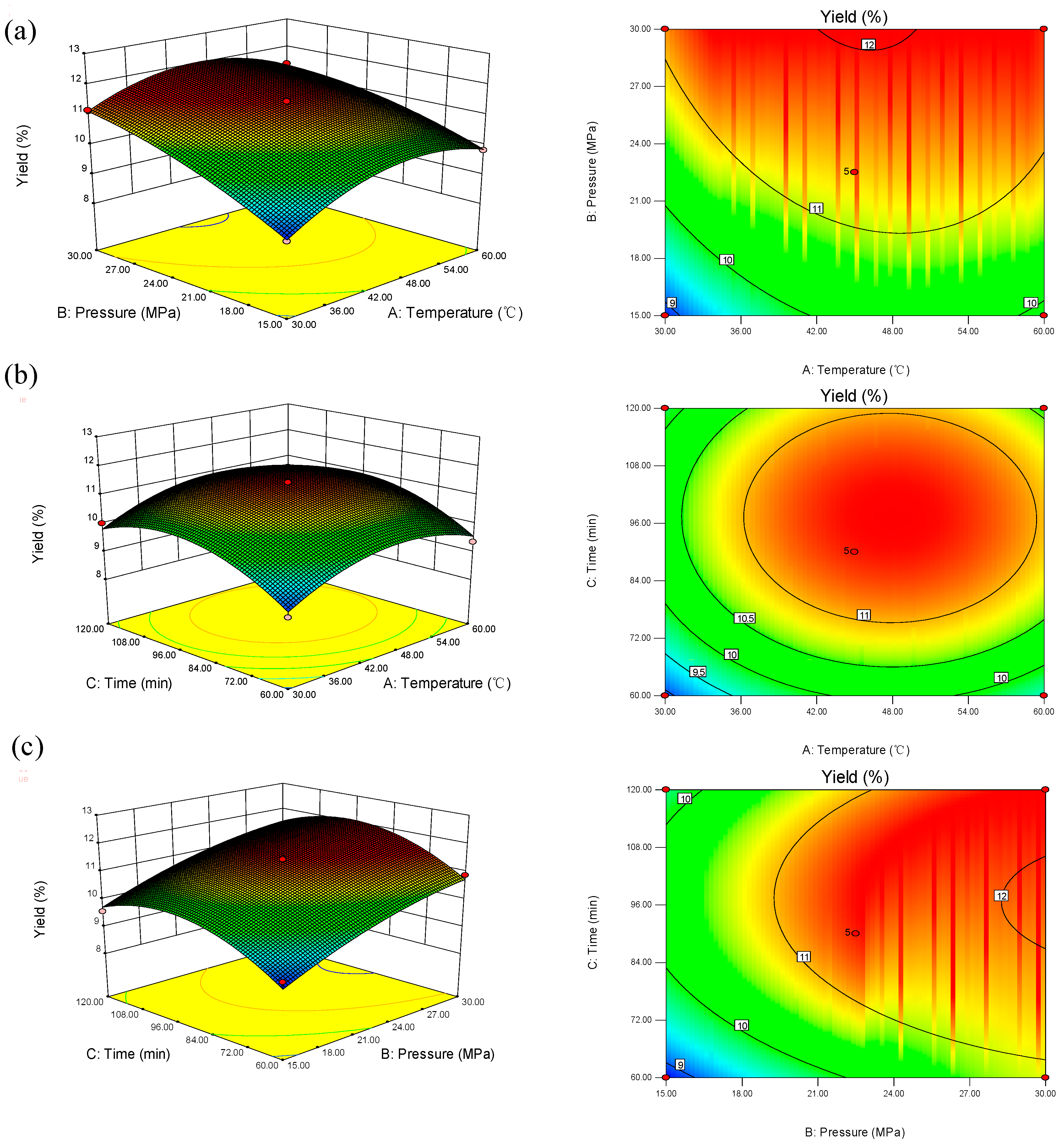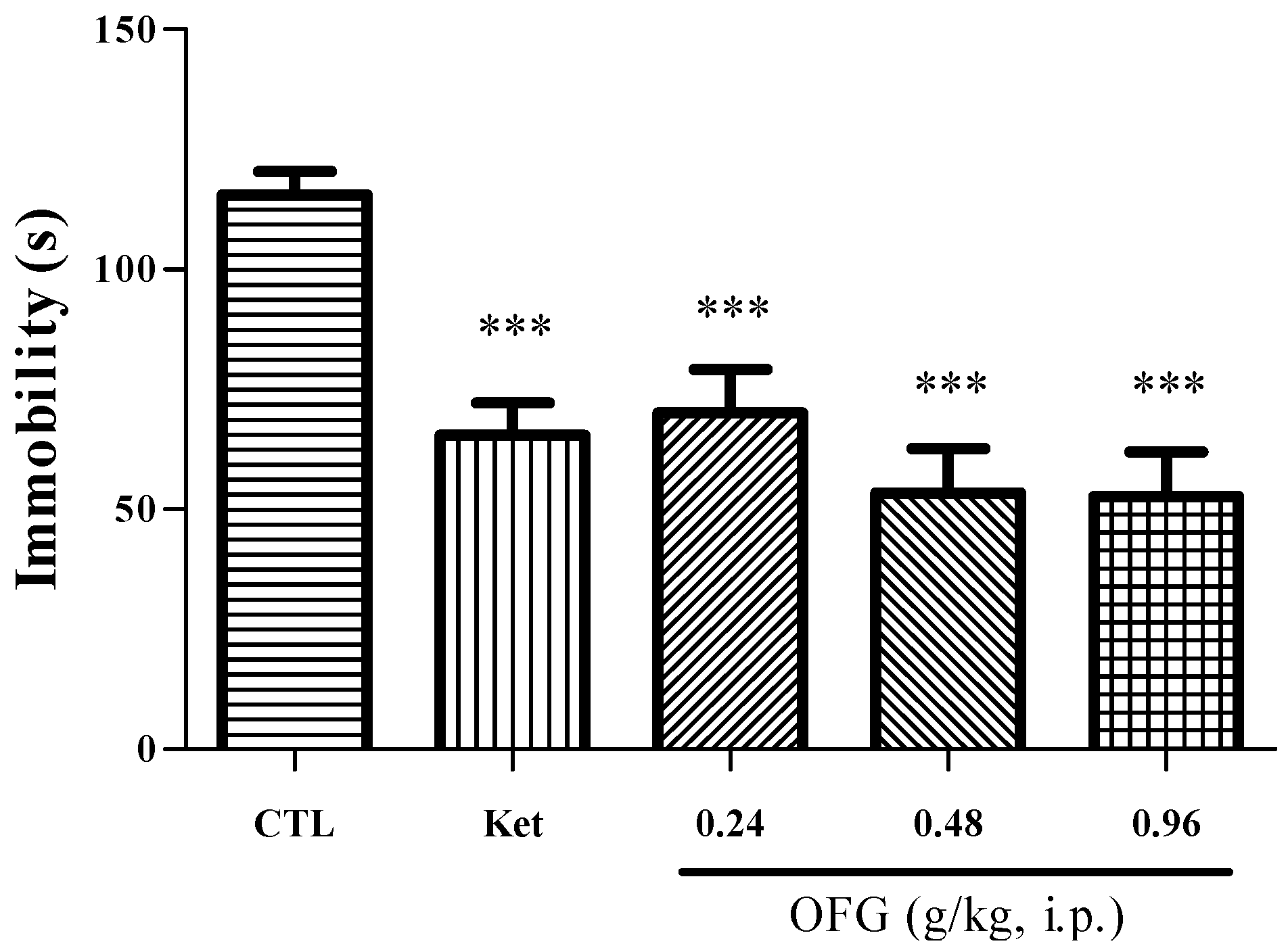Optimization of Supercritical Fluid Extraction of Oil from the Fruit of Gardenia jasminoides and Its Antidepressant Activity
Abstract
:1. Introduction
2. Results and Discussion
2.1. Optimization of the Extraction of OFG from FG Using RSM
| Standard | Run | A | B | C | Oil recovery (%) |
|---|---|---|---|---|---|
| 12 | 1 | 45 | 30.0 | 120 | 11.30 |
| 4 | 2 | 60 | 30.0 | 90 | 11.39 |
| 11 | 3 | 45 | 15.0 | 120 | 9.57 |
| 13 | 4 | 45 | 22.5 | 90 | 11.48 |
| 2 | 5 | 60 | 15.0 | 90 | 9.83 |
| 10 | 6 | 45 | 30.0 | 60 | 10.89 |
| 14 | 7 | 45 | 22.5 | 90 | 11.37 |
| 8 | 8 | 60 | 22.5 | 120 | 10.59 |
| 9 | 9 | 45 | 15.0 | 60 | 9.00 |
| 5 | 10 | 30 | 22.5 | 60 | 8.72 |
| 3 | 11 | 30 | 30.0 | 90 | 11.16 |
| 6 | 12 | 60 | 22.5 | 60 | 9.36 |
| 16 | 13 | 45 | 22.5 | 90 | 11.31 |
| 17 | 14 | 45 | 22.5 | 90 | 11.41 |
| 7 | 15 | 30 | 22.5 | 120 | 10.02 |
| 15 | 16 | 45 | 22.5 | 90 | 11.45 |
| 1 | 17 | 30 | 15.0 | 90 | 8.79 |
| Source | Sum of Squares | Degree of Freedom | Mean Square | F-Value | p-value Prob > F |
|---|---|---|---|---|---|
| Model | 16.96 | 9 | 1.88 | 40.31 | <0.0001 |
| A-temperature | 0.77 | 1 | 0.77 | 16.44 | 0.0048 |
| B-pressure | 7.13 | 1 | 7.13 | 152.39 | <0.0001 |
| C-time | 1.54 | 1 | 1.54 | 32.94 | 0.0007 |
| AB | 0.16 | 1 | 0.16 | 3.51 | 0.1032 |
| AC | 1.225 × 10−3 | 1 | 1.225 × 10−3 | 0.026 | 0.8760 |
| BC | 6.400 × 10−3 | 1 | 6.400 × 10−3 | 0.14 | 0.7223 |
| A2 | 2.8 | 1 | 2.8 | 59.89 | 0.0001 |
| B2 | 0.37 | 1 | 0.37 | 8.00 | 0.0255 |
| C2 | 3.55 | 1 | 3.55 | 75.89 | <0.0001 |
| - | R2 = 0.981 | - | adjusted R2 = 0.957 | - | - |

2.2. Chemical Compositions of OFG
| No | Component | Relative Content | Molecular Formula | Molecular Weight | Degree of Similarity (%) |
|---|---|---|---|---|---|
| 1 | 2-Heptenal | 0.72 | C7H12O | 112 | 98 |
| 2 | 2-Pentylfuran | 3.37 | C9H14O | 138 | 97 |
| 3 | Caproic acid | 0.24 | C6H12O2 | 116 | 99 |
| 4 | 2,2,6-Trimethylcyclohexanone | 9.65 | C9H16O | 140 | 98 |
| 5 | 2,5-Dimethylbenzaldehyde | 3.23 | C9H10O | 134 | 96 |
| 6 | Linalool | 3.96 | C10H18O | 154 | 98 |
| 7 | 2,6,6-Trimethyl-1,3-Cyclohexadiene-1-Carboxaldehyde | 11.72 | C10H14O | 150 | 98 |
| 8 | Eucarvone | 2.17 | C10H14O | 150 | 98 |
| 9 | 2,4-Decadienal | 7.30 | C10H16O | 152 | 99 |
| 10 | β-Elemene | 1.22 | C15H2 | 204 | 95 |
| 11 | α-Guaiene | 0.76 | C15H24 | 204 | 96 |
| 12 | Pentadecane | 15.14 | C15H32 | 212 | 97 |
| 13 | Heptadecane | 6.16 | C17H36 | 240 | 98 |
| 14 | 2-Methyl-Heptadecane | 2.11 | C18H38 | 254 | 97 |
| 15 | Myristic acid | 15.30 | C14H28O2 | 228 | 96 |
| 16 | Palmitic acid | 13.70 | C16H32O2 | 256 | 98 |
2.3. Antidepressant Activity Evaluation
2.3.1. Tail Suspension Test
2.3.2. Forced Swimming Test


3. Experimental Section
3.1. Animals
3.2. Materials
3.3. SFE-CO2 Extraction
3.4. Experimental Design and Statistical Analysis

| Symbol | Independent Variable | Coded Levels | ||
|---|---|---|---|---|
| −1 | 0 | 1 | ||
| X1 | Temperature (°C) | 30 | 45 | 60 |
| X2 | Pressure (MPa) | 15 | 22.5 | 30 |
| X3 | Time (min) | 60 | 90 | 120 |
3.5. Gas Chromatography-Mass Spectrometry Analysis
3.6. Antidepressant Activity Evaluation
3.6.1. Tail Suspension Test (TST)
3.6.2. Forced Swim Test (FST)
4. Conclusions
Acknowledgments
Author Contributions
Conflicts of Interest
References
- Liu, S.L.; Lin, Y.C.; Huang, T.H.; Huang, S.W.; Peng, W.H. Anti-depressive activity of Gardeniae fructus and geniposide in mouse models of depression. Afr. J. Pharm. Pharmaco. 2011, 5, 1580–1588. [Google Scholar]
- Dong, W.R.; Liu, H.Y.; Ding, Y.G.; Wang, H.P.; Liu, S.M. Interpretation of a TCM theory about clearing and discharging the triple burner damp-heat of Gardenia jasminoides Ellis. China J. Trad. Chin. Med. Pharm. 2011, 26, 33–35. [Google Scholar]
- Debnath, T.; Park, P.J.; Nath, N.C.D.; Samad, N.B.; Lim, B.O. Antioxidant activity of Gardenia jasminoides Ellis fruit extracts. Food Chem. 2011, 128, 697–703. [Google Scholar]
- Koo, H.J.; Lim, K.H.; Jung, H.J.; Park, E.H. Anti-inflammatory evaluation of gardenia extract, geniposide and genipin. J. Ethnopharmacol. 2006, 103, 496–500. [Google Scholar]
- Akihisa, T.; Watanabe, K.; Yamamoto, A.; Zhang, J.; Matsumoto, M.; Fukatsu, M. Melanogenesis Inhibitory Activity of Monoterpene Glycosides from Gardeniae Fructus. Chem. Biodivers. 2012, 9, 1490–1499. [Google Scholar]
- Lee, S.J.; Oh, P.S.; Lim, K.T. Hepatoprotective and hypolipidaemic effects of glycoprotein isolated from Gardenia jasminoides Ellis in mice. Clin. Exp. Pharmacol. Physiol. 2006, 33, 925–933. [Google Scholar]
- Lee, J.H.; Lee, D.U.; Jeong, C.S. Gardenia jasminoides Ellis ethanol extract and its constituents reduce the risks of gastritis and reverse gastric lesions in rats. Food Chem. Toxicol. 2009, 47, 1127–1131. [Google Scholar]
- Chang, K.H.; Chen, W.L.; Wu, Y.R.; Lin, T.H.; Wu, Y.C.; Chao, C.Y.; Lin, J.Y.; Lee, L.C.; Chen, Y.C.; Lee-Chen, G.J.; et al. Aqueous extract of Gardenia jasminoides targeting oxidative stress to reduce polyQ aggregation in cell models of spinocerebellar ataxia 3. Neuropharmacology 2014, 81, 166–175. [Google Scholar]
- Lin, Y.J.; Lai, C.C.; Lai, C.H.; Sue, S.C.; Lin, C.W.; Hung, C.H.; Lin, T.H.; Hsu, W.Y.; Huang, S.M.; Hung, Y.L.; et al. Inhibition of enterovirus 71 infections and viral IRES activity by Fructus gardeniae and geniposide. Eur. J. Med. Chem. 2013, 62, 206–213. [Google Scholar]
- Hassani, F.V.; Naseri, V.; Razavi, B.M.; Mehri, S.; Abnous, K.; Hosseinzadeh, H. Antidepressant effects of crocin and its effects on transcript and protein levels of CREB, BDNF, and VGF in rat hippocampus. Daru J. Pharm. Sci. 2014, 22. [Google Scholar] [CrossRef]
- Chen, Z.C.; Mei, X.; Jin, Y.X.; Kim, E.-H.; Yang, Z.Y.; Tu, Y.Y. Optimisation of supercritical carbon dioxide extraction of essential oil of flowers of tea (Camellia sinensis L.) plants and its antioxidative activity. J. Sep. Sci. 2014, 94, 316–321. [Google Scholar]
- Mukhopadhyay, M. Natural Extracts Using Supercritical Carbon Dioxide, 2nd ed.; CRC Press: Boca Raton, FL, USA, 2000; pp. 13–39. [Google Scholar]
- Kim, S.; Yun, E.J.; Bak, J.S.; Lee, H.; Lee, S.J.; Kim, C.T.; Lee, J.-H.; Kim, K.H. Response surface optimised extraction and chromatographic purification of rosmarinic acid from Melissa officinalis leaves. Food Chem. 2010, 121, 521–526. [Google Scholar]
- Zhou, J.; Ma, X.M.; Qiu, B.H.; Chen, J.X.; Bian, L.; Pan, L.M. Parameters optimization of supercritical fluid-CO2 extracts of frankincense using response surface methodology and its pharmacodynamics effects. J. Sep. Sci. 2013, 36, 383–390. [Google Scholar]
- Xue, W.D.; Zhou, X.; Yi, N.; Jiang, L.H.; Tao, W.W.; Wu, R.J.; Wang, D.; Jiang, J.J.; Ge, X.J.; Wang, Y.Y.; et al. Yueju pill rapidly induces antidepressant-like effects and acutely enhances BDNF expression in mouse brain. Evid. Based Complement. Alternat. Med. 2013, 2013. [Google Scholar] [CrossRef]
- Willner, P. Validity, reliability and utility of the chronic mild stress model of depression: A 10-year review and evaluation. Psychopharmacology 1997, 134, 319–329. [Google Scholar]
- Sample Availability: Samples of the compounds are not available from the authors.
© 2014 by the authors. Licensee MDPI, Basel, Switzerland. This article is an open access article distributed under the terms and conditions of the Creative Commons Attribution license ( http://creativecommons.org/licenses/by/4.0/).
Share and Cite
Tao, W.; Zhang, H.; Xue, W.; Ren, L.; Xia, B.; Zhou, X.; Wu, H.; Duan, J.; Chen, G. Optimization of Supercritical Fluid Extraction of Oil from the Fruit of Gardenia jasminoides and Its Antidepressant Activity. Molecules 2014, 19, 19350-19360. https://doi.org/10.3390/molecules191219350
Tao W, Zhang H, Xue W, Ren L, Xia B, Zhou X, Wu H, Duan J, Chen G. Optimization of Supercritical Fluid Extraction of Oil from the Fruit of Gardenia jasminoides and Its Antidepressant Activity. Molecules. 2014; 19(12):19350-19360. https://doi.org/10.3390/molecules191219350
Chicago/Turabian StyleTao, Weiwei, Hailou Zhang, Wenda Xue, Li Ren, Baomei Xia, Xin Zhou, Haoxin Wu, Jinao Duan, and Gang Chen. 2014. "Optimization of Supercritical Fluid Extraction of Oil from the Fruit of Gardenia jasminoides and Its Antidepressant Activity" Molecules 19, no. 12: 19350-19360. https://doi.org/10.3390/molecules191219350
APA StyleTao, W., Zhang, H., Xue, W., Ren, L., Xia, B., Zhou, X., Wu, H., Duan, J., & Chen, G. (2014). Optimization of Supercritical Fluid Extraction of Oil from the Fruit of Gardenia jasminoides and Its Antidepressant Activity. Molecules, 19(12), 19350-19360. https://doi.org/10.3390/molecules191219350




